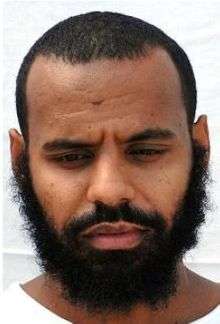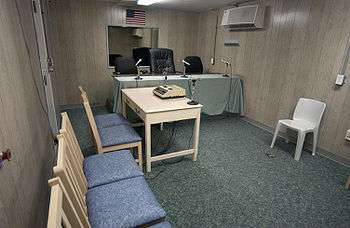Salem Ahmed Hadi
Salem Ahmed Hadi is a citizen of Yemen, who was held in extrajudicial detention in the United States Guantanamo Bay detainment camps, in Cuba.[1] His detainee ID number is 131. Joint Task Force Guantanamo counter-terrorism analysts reports that Hadi was born on January 15, 1976, in Hadramaut, Yemen.
| Salem Ahmed Hadi | |
|---|---|
 | |
| Detained at | Guantanamo |
| ISN | 131 |
| Charge(s) | no charge, held in extrajudicial detention |
| Status | transferred to Saudi Arabia on 2017-01-05 |
He was transferred to Saudi Arabia on January 5, 2017.[2]
Inconsistent identification
Salem was named inconsistently on the official lists:
Official status reviews
Originally the Bush Presidency asserted that captives apprehended in the "war on terror" were not covered by the Geneva Conventions, and could be held indefinitely, without charge, and without an open and transparent review of the justifications for their detention.[5] In 2004 the United States Supreme Court ruled, in Rasul v. Bush, that Guantanamo captives were entitled to being informed of the allegations justifying their detention, and were entitled to try to refute them.
Office for the Administrative Review of Detained Enemy Combatants

Following the Supreme Court's ruling the Department of Defense set up the Office for the Administrative Review of Detained Enemy Combatants.[5][8]
Scholars at the Brookings Institution, lead by Benjamin Wittes, listed the captives still held in Guantanamo in December 2008, according to whether their detention was justified by certain common allegations:[9]
- Salem Ahmed Ben Kend was listed as one of the captives who "The military alleges ... traveled to Afghanistan for jihad."[9]
- Salem Ahmed Ben Kend was listed as one of the captives who "The military alleges ... took military or terrorist training in Afghanistan."[9]
- Salem Ahmed Ben Kend was listed as one of the captives who "The military alleges ... fought for the Taliban."[9]
- Salem Ahmed Ben Kend was listed as one of the captives whose "names or aliases were found on material seized in raids on Al Qaeda safehouses and facilities."[9]
- Salem Ahmed Ben Kend was listed as one of the captives who "The military alleges that the following detainees were captured under circumstances that strongly suggest belligerency."[9]
- Salem Ahmed Ben Kend was listed as one of the captives who was a foreign fighter.[9]
- Salem Ahmed Ben Kend was listed as one of "36 [captives who] openly admit either membership or significant association with Al Qaeda, the Taliban, or some other group the government considers militarily hostile to the United States."[9]
- Salem Ahmed Ben Kend was listed as one of the captives who had admitted "fighting on behalf of Al Qaeda or the Taliban."[9]
A Summary of Evidence memo was prepared for Salem Ahmed Ben Kend's Combatant Status Review Tribunal, on 7 October 2004.[10][11] The memo listed the following allegations against him:
Salem did not attend his 2005 Board hearing.[12] But a five-page summarized transcript recorded the discussion of his interview with his Assisting Military Officer.
Formerly secret Joint Task Force Guantanamo assessment
On April 25, 2011, whistleblower organization WikiLeaks published formerly secret assessments drafted by Joint Task Force Guantanamo analysts.[13][14] His 9-page Joint Task Force Guantanamo assessment was drafted on April 8, 2008.[4] It was signed by camp commandant Rear Admiral Mark H. Buzby. He recommended continued detention.
References
-
OARDEC. "List of Individuals Detained by the Department of Defense at Guantanamo Bay, Cuba from January 2002 through May 15, 2006" (PDF). United States Department of Defense. Archived (PDF) from the original on 2007-09-30. Retrieved 2006-05-15.

-
Charlie Savage (2017-01-05). "4 Yemeni Detainees at Guantánamo Are Transferred to Saudi Arabia". Washington DC: New York Times. Retrieved 2017-01-05.
The Pentagon announced on Thursday that it had transferred four Yemeni detainees from the wartime prison at Guantánamo Bay, Cuba, to Saudi Arabia, beginning an expected flurry of transfers in the waning days of the Obama administration.
- list of prisoners (.pdf), US Department of Defense, April 20, 2006
- "Salim Ahmed Haddi Hathramoot: Guantanamo Bay detainee file on Salim Ahmed Haddi Hathramoot, US9YM-000131DP, passed to the Telegraph by Wikileaks". The Telegraph (UK). 2011-04-27. Retrieved 2016-07-09.
-
"U.S. military reviews 'enemy combatant' use". USA Today. 2007-10-11. Archived from the original on 2012-08-11.
Critics called it an overdue acknowledgment that the so-called Combatant Status Review Tribunals are unfairly geared toward labeling detainees the enemy, even when they pose little danger. Simply redoing the tribunals won't fix the problem, they said, because the system still allows coerced evidence and denies detainees legal representation.
- Guantánamo Prisoners Getting Their Day, but Hardly in Court, New York Times, November 11, 2004 - mirror Archived 2007-09-30 at the Wayback Machine
- Inside the Guantánamo Bay hearings: Barbarian "Justice" dispensed by KGB-style "military tribunals", Financial Times, December 11, 2004
- "Q&A: What next for Guantanamo prisoners?". BBC News. 2002-01-21. Archived from the original on 24 November 2008. Retrieved 2008-11-24.CS1 maint: BOT: original-url status unknown (link)
- Benjamin Wittes, Zaathira Wyne (2008-12-16). "The Current Detainee Population of Guantánamo: An Empirical Study". The Brookings Institution. Archived from the original (PDF) on 2012-06-22. Retrieved 2010-02-16.
- OARDEC (7 October 2004). "Summary of Evidence for Combatant Status Review Tribunal -- redacted" (PDF). United States Department of Defense. pp. 181–182. Archived from the original (PDF) on 31 July 2006.
- OARDEC (7 October 2004). "Summary of Evidence for Combatant Status Review Tribunal -- Ben Kend, Salem Ahmed" (PDF). United States Department of Defense. pp. 42–43. Archived from the original (PDF) on 4 December 2007. Retrieved 2007-12-04.
- OARDEC (2005). "Summary of Administrative Review Board Proceedings of ISN" (PDF). United States Department of Defense. pp. 153–157. Retrieved 2007-12-04.
-
Christopher Hope, Robert Winnett, Holly Watt, Heidi Blake (2011-04-27). "WikiLeaks: Guantanamo Bay terrorist secrets revealed -- Guantanamo Bay has been used to incarcerate dozens of terrorists who have admitted plotting terrifying attacks against the West – while imprisoning more than 150 totally innocent people, top-secret files disclose". The Telegraph (UK). Archived from the original on 2012-07-13. Retrieved 2012-07-13.
The Daily Telegraph, along with other newspapers including The Washington Post, today exposes America’s own analysis of almost ten years of controversial interrogations on the world’s most dangerous terrorists. This newspaper has been shown thousands of pages of top-secret files obtained by the WikiLeaks website.
CS1 maint: multiple names: authors list (link) - "WikiLeaks: The Guantánamo files database". The Telegraph (UK). 2011-04-27. Archived from the original on 2015-06-26. Retrieved 2012-07-10.